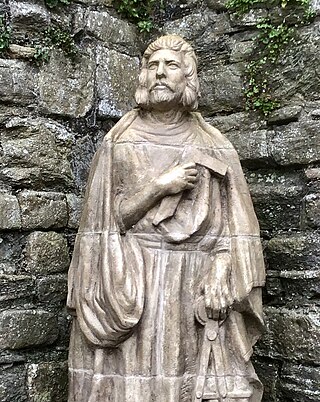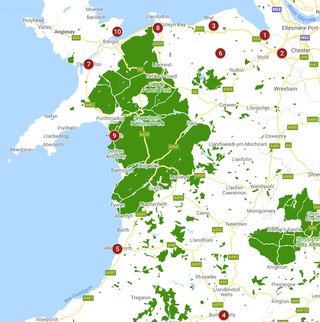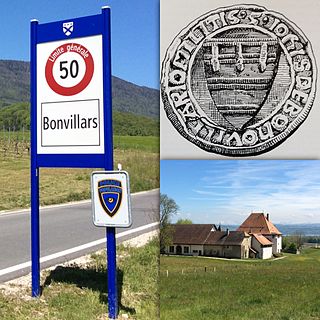
Master James of Saint George was a master of works/architect from Savoy, described by historian Marc Morris as "one of the greatest architects of the European Middle Ages". He was largely responsible for designing King Edward I's castles in North Wales, including Conwy, Harlech and Caernarfon and Beaumaris on Anglesey.

Harlech Castle in Harlech, Gwynedd, Wales, is a Grade I listed medieval fortification built onto a rocky knoll close to the Irish Sea. It was built by Edward I during his invasion of Wales between 1282 and 1289 at the relatively modest cost of £8,190. Over the next few centuries, the castle played an important part in several wars, withstanding the siege of Madog ap Llywelyn between 1294 and 1295, but falling to Prince Owain Glyndŵr in 1404. It then became Glyndŵr's residence and military headquarters for the remainder of the uprising until being recaptured by English forces in 1409. During the 15th century Wars of the Roses, Harlech was held by the Lancastrians for seven years, before Yorkist troops forced its surrender in 1468, a siege memorialised in the song "Men of Harlech". Following the outbreak of the English Civil War in 1642, the castle was held by forces loyal to Charles I, holding out until 1647 when it became the last fortification to surrender to the Parliamentary armies. In the 21st century the ruined castle is managed by Cadw, the Welsh Government's historic environment service, as a tourist attraction.

Conwy Castle is a fortification in Conwy, located in North Wales. It was built by Edward I, during his conquest of Wales, between 1283 and 1287. Constructed as part of a wider project to create the walled town of Conwy, the combined defences cost around £15,000, a massive sum for the period. Over the next few centuries, the castle played an important part in several wars. It withstood the siege of Madog ap Llywelyn in the winter of 1294–95, acted as a temporary haven for Richard II in 1399 and was held for several months by forces loyal to Owain Glyndŵr in 1401.

Madog ap Llywelyn was the leader of the Welsh revolt of 1294–95 against English rule in Wales. The revolt was surpassed in longevity only by the revolt of Owain Glyndŵr in the 15th century. Madog belonged to a junior branch of the House of Aberffraw and was a distant relation of Llywelyn ap Gruffudd, the last recognised native Prince of Wales. During his revolt, Madog issued a land grant in which he used the title "Prince of Wales".

Flint Castle in Flint, Flintshire, was the first of a series of castles built during King Edward I's campaign to conquer Wales.

Rhuddlan Castle is a castle located in Rhuddlan, Denbighshire, Wales. It was erected by Edward I in 1277, following the First Welsh War.

Wales in the late Middle Ages spanned the years 1282–1542, beginning with conquest and ending in union. Those years covered the period involving the closure of Welsh medieval royal houses during the late 13th century, and Wales' final ruler of the House of Aberffraw, the Welsh Prince Llywelyn II, also the era of the House of Plantagenet from England, specifically the male line descendants of Geoffrey Plantagenet, Count of Anjou as an ancestor of one of the Angevin kings of England who would go on to form the House of Tudor from England and Wales.

The Ring of Iron or Iron Ring of Castles was a chain of fortifications and castles built across Wales at Edward I's command after the death of Llywelyn ap Gruffudd in 1282 and the subsequent Conquest of Wales by Edward I of England. Edward spent over £80,000 on all of the castles, with £20,000 being incurred just by Rhuddlan Castle, Aberystwyth Castle, Flint Castle, and Builth Castle.

The Castles and Town Walls of King Edward in Gwynedd is a UNESCO-designated World Heritage Site located in Gwynedd, Wales. It includes the castles of Beaumaris and Harlech and the castles and town walls of Caernarfon and Conwy. UNESCO considers the sites to be the "finest examples of late 13th century and early 14th century military architecture in Europe".

Otto de Grandson, sometimes numbered Otto I to distinguish him from later members of his family with the same name, was the most prominent of the Savoyard knights in the service of King Edward I of England, to whom he was the closest personal friend and many of whose interests he shared.

Vanclans is a former commune in the Doubs department in the Bourgogne-Franche-Comté region in eastern France.
The Justiciar of North Wales was a legal office concerned with the government of the three counties in north-west Wales during the medieval period. Justiciar was a title which had been given to one of the monarch's chief ministers in both England and Scotland. Following Edward I of England's conquest of North Wales (1277–1283), the counties of Anglesey, Caernarfonshire and Merioneth were created out of the Kingdom of Gwynedd by the Statute of Rhuddlan in 1284 and placed under direct royal control. The Justiciar of North Wales was responsible for the royal administration in these counties as well as the administration of justice. English law was applied to criminal law, but in other matters Welsh law was allowed to continue.

Caernarfon Castle is a medieval fortress in Gwynedd, north-west Wales. The first fortification on the site was a motte-and-bailey castle built in the late 11th century, which King Edward I of England began to replace with the current stone structure in 1283. The castle and town established by Edward acted as the administrative centre of north Wales, and as a result the defences were built on a grand scale. There was a deliberate link with Caernarfon's Roman past—nearby is the Roman fort of Segontium—and the castle's walls are reminiscent of the Walls of Constantinople.

Chenaux Castle is a castle in the municipality of Estavayer-le-Lac of the Canton of Fribourg in Switzerland. It is a Swiss heritage site of national significance.

The conquest of Wales by Edward I took place between 1277 and 1283. It is sometimes referred to as the Edwardian conquest of Wales, to distinguish it from the earlier Norman conquest of Wales. In two campaigns, in 1277 and 1282–83, respectively, Edward I of England first greatly reduced the territory of Llywelyn ap Gruffudd, and then completely overran it, as well as the other remaining Welsh principalities.

Sir John de Bonvillars (c. ?–1287) was a medieval Savoyard knight in the service of Edward I. He was the brother in law of Otto de Grandson, and like William de Cicon, had been introduced to English service by Otto.
John Chaumpeneys was the last Abbot of Darnhall Abbey and first Abbot of Vale Royal Abbey, Cheshire, from around 1275 to circ 1289.

Ebulo de Montibus Born as a younger son of Ebal I de Mont and his wife, Beatrice, Ebal II was first noted in 1237. Born in the Pays de Vaud, now Switzerland then Savoy. The Famille de Mont held the castle at Mont-le-Grand near Rolle. Better known in English records as Ebulo de Montibus, Ebal II de Mont had travelled to England by 1246. A household knight of King Henry III of England, granted much land in England. By 1256 he was part of the Savoyard circle of the Lord Edward, later King Edward I of England. Recorded as a Steward in the household of King Henry III of England from 12 November 1256 until 26 May 1263. A witness for King Henry III at the Mise of Amiens, where he swore for the king's good conduct in accepting King Louis XIVs arbitration. Left England during the Second Barons' War with Queen Eleanor of Provence and Peter II, Count of Savoy and active in attempting to raise an army loyal to the crown. Rewarded for his loyalty by being made Constable of Windsor Castle.

Pierre de Champvent was a noble originally from Savoy who made a career as a military and courtier in England.





















